














SUMMER 2022 1 THE BU G LE SUMMER 2022 | VOLUME 29: 2

7 | FROM THE SECRETARY 9 | FROM THE DIRECTOR 10-11 | EVERY VETERAN IS A STORY 12-13 | FROM THE COLLECTION 14-16 | BEYOND BILLY MITCHELL 17 | CEMETERY TOURS 18-19 | FROM THE ARCHIVES 21 | MEET THE STAFF 22-23 | BEHIND THE SCENES 24-25 | FROM THE FOUNDATION 26 | CALENDAR 27 | THANK YOU DONORS
C ONTENTS
Merton W. Baker, a Tomahawk, Wisconsin resident served in the US Army Air Corps in World War II and later with the US Air Force until his retirement from service in 1981. In the US Army Air Corps, Baker served as a pilot flying various aircraft. In 1953, Baker returned to active duty with the air force as a pilot, pilot instructor and in various command, testing and approval roles until his retirement. General Baker was a command pilot with 185 combat missions and more than 7,000 flying hours, the majority of which were in B-47s, B-52s, T-33s, Cessna T-37 Tweets, T-39 Sabreliners and EB-66s. Baker was promoted to major general June 1, 1980, with date of rank July 1, 1976. He retired on April 1, 1981 and continued to live in New Mexico until his death in 2000. He is buried at Santa Fe National Cemetery in New Mexico.
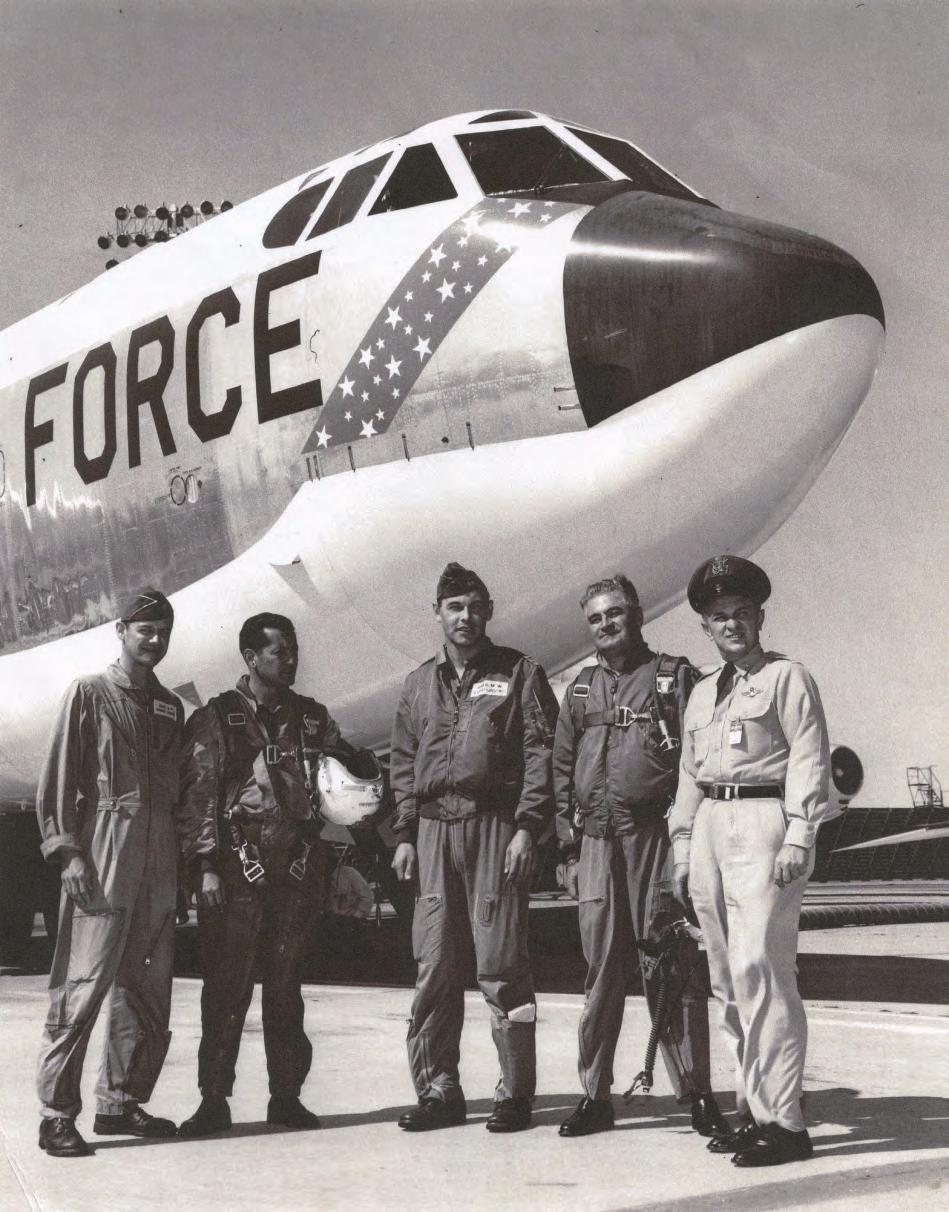 Photograph from the Merton W. Baker collection, WVM Mss 2261. This photograph features Baker, center, with other US Air Force servicemembers, in front of an air force plane.
Photograph from the Merton W. Baker collection, WVM Mss 2261. This photograph features Baker, center, with other US Air Force servicemembers, in front of an air force plane.
MUSEUM STAFF DIRECTOR

CHRISTOPHER L. KOLAKOWSKI | 608.266.1009
ASSISTANT DIRECTOR
JENNIFER VAN HAAFTEN | 608.261.6802
OPERATIONS ASSISTANT
ELISE MCFARLANE | 608.261.0534
ORAL HISTORIAN
LUKE SPRAGUE | 608.261.0537
CURATOR OF HISTORY
KEVIN HAMPTON | 608.261.5409
PROCESSING ARCHIVIST



BRITTANY STROBEL | 608.800.6958
COLLECTIONS MANAGER
ANDREA HOFFMAN | 608.800.6957
REFERENCE ARCHIVIST
RUSS HORTON | 608.267.1790
REGISTRAR
SARAH KAPELLUSCH | 608.800.6955
CURATOR OF EXHIBITS
GREGORY KRUEGER | 608.261.0541
STORE MANAGER
GREG LAWSON | 608.261.0535
MARKETING SPECIALIST, SR. JENNIFER STEVENSON | 608.264.6068

CURATOR OF VETERAN ART
YVETTE PINO | 608.266.1854
EDUCATION SPECIALIST
30 WEST MIFFLIN STREET MADISON, WI 53703
ON THE CAPITOL SQUARE 608.267.1799
wisvetsmuseum.com
MUSEUM HOURS
Closed Mondays
Tuesday− Thursday, Saturday 10:00 AM–5:00PM

Friday 10:00 AM–6:00PM
Sunday (April–September) Noon–5:00 PM
RESEARCH CENTER HOURS
By appointment only 608.267.1790
ERIK WRIGHT | 608.264.7663 Join
COMMENTS & SUBMISSIONS
We welcome your comments and editorial submissions concerning The Bugle. Comments and submissions should be sent to Jennifer Stevenson at Jennifer.Stevenson@dva.wisconsin.gov
THE WISCONSIN VETERANS MUSEUM
Us Online!
FOUNDATION BOARD OF DIRECTORS
PRESIDENT
DAN CHECKI
VICE PRESIDENT
JOANE MATHEWS
TREASURER
DAVE HEILIGER
SECRETARY
TOM HUISMANN
DIRECTORS AT LARGE
ALEJANDRO ARANGO-ESCALANTE
DAN GREENE
WILLIAM F. HUSTAD
TIMOTHY LA SAGE
JOSEPH NAYLOR
PHIL PRANGE
BOB SIMMONS
NATHANIEL T. MILSAP, JR.
JEFF BOUDREAU
PAUL MCEVILLY
COLLECTION DONORS
2/12/22-5/6/22
FOUNDATION STAFF
EXECUTIVE DIRECTOR
JENNIFER CARLSON
608.261.0536
JENNIFER.CARLSON@ WVMFOUNDATION.COM
A most sincere thank you to all who donated to our collection from February 2022–May 2022. Thank you for your generosity and support of the Wisconsin Veterans Museum.
Becky Bartlett
Richard Berry
Janet Besadny
Nat Blonien
Douglas Bradley
Bob Buhr
Richard Campbell
Sheila Connolly-Lederer
June Fischer
Anthony Fleres
Mary Griffin
Alice Gustafson
Stephanie Hart
James Kerstein
John Koeppen
Allyn Lepeska
Gary Mahr
Jean O’Neil
Rick Rasmussen
Scott Roberts
Ed Ruckriegel
Mackenzie Ryan
Adam Salm
Mary Kay Schimming
Marc Storch
Theodore Raymond Thompson
USS Wisconsin SSBN-827 Assn.
Ken Valdovinos
Sarah Wegmueller
Wisconsin Commandery of the Military Order of the Loyal Legion of the United States
MUSEUM MISSION
The mission of the Wisconsin Veterans Museum is to commemorate, acknowledge, and affirm the role of Wisconsin veterans in America’s military past and present
The Bugle is published quarterly for our members and friends through the support of the Wisconsin Veterans Museum Foundation. The Wisconsin Veterans Museum Foundation provides funds for the support of artifact acquisitions, exhibit production, and the development of educational programs.
May 1981 marked the beginning of a hunger strike for a group of Vietnam veterans in Los Angeles who demanded a closer look at the toxic effects of Agent Orange and sought additional medical services at VA hospitals to handle the herbicide’s lingering fallout. By June, their fight moved to the nation’s capital and included additional hunger strikers from across the country, including Wisconsin veteran Tom Langkau. The Vietnam Veterans Against the War chapter in Milwaukee collected this screen-printed banner promoting their Vietnam veteran homecoming event to be held in Washington, D.C. on July 4, 1981 to help raise awareness of their cause and draw attention to the continuing issues surrounding Agent Orange exposure. (V1991.58.14)





6
FROM THE SECRETARY

Greetings! Thank you for your support of the Wisconsin Veterans Museum. Summer-like weather has finally returned, and we are so grateful to see so many of you come back to visit our wonderful museum.
It is fantastic to see so many school tours being scheduled once again and to see them reach nearly pre-pandemic numbers. The positive vocal response from visitors continues to be outstanding. From the new Souvenirs of Service exhibit to the refreshed displays and various new stories that are showcased, the museum is a sight to see. It is thrilling to see so many visitors stop by from all corners of our state, the nation, and the world.
This issue of The Bugle is special—it focuses on veteran stories from the northwestern corner of our state from communities in the counties of Ashland, Bayfield, Burnette, Douglas, Iron, Sawyer, and Washburn. It is also important to take note that these counties also are home to five of Wisconsin’s 11 tribal nations, whose veteran tribal members proudly served in our armed forces. There is a special, tight-knit veteran community in these counties, and I am so thankful to see this region's veterans' stories put in the spotlight.
As a part of the Wisconsin Department of Veterans Affairs, the Wisconsin Veterans Museum is a benefit for our veterans as an institution meant to preserve their experiences for future generations. Indeed, as the museum says, “Every Veteran Is A Story,” which is true no matter what era, service, or circumstance. As I travel around the state, I enjoy listening to veterans’ experiences while sharing some of the powerful stories in the museum’s collections. The impact of sharing veteran stories is incredible, truly an amazing way to connect people across the years. I continue to be impressed by the meticulous work our museum’s director, Chris Kolakowski, and his curators do to highlight unique and important veteran stories from all parts of our state.
We know there are always more stories to learn about and share. One initiative we look forward to continuing is collecting photos of every Wisconsin veteran that we can. It is important to recognize the faces behind the facts and preserve them. Please consider submitting a photo and the background of a Wisconsin veteran on the museum’s website. Remember, if a veteran served 50 years ago or five years ago, their story is a vital part of our history.
Summer is a wonderful time in our state, and as more visitors get to experience the museum, we have more opportunities to tell the stories of our Wisconsin veterans.
I hope you can stop by this summer, perhaps even over the Fourth of July weekend, so you can experience our museum for yourself and connect with the proud history of our Wisconsin veterans.
With shared camaraderie,
Mary M. Kolar Secretary, Wisconsin Department of Veterans Affairs
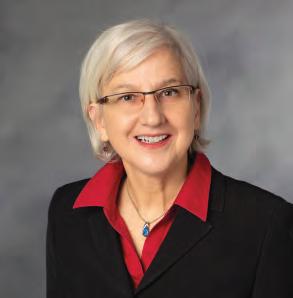
SUMMER 2022 7
From the Gordon F. Klein collection. Klein, a Wausau, Wisconsin resident served with the Army Medical Corps as an aerial photographer-gunner with the 5th Bombardment Group (H), 13th Air Corps in World War II. While serving with the 13th Air Corps, Klein was stationed in the South Pacific and appears to have been stationed on Guadalcanal for a time. After his service, Gordon Klein returned to Wisconsin and his to wife, Emily. The caption on this photo reads, “Prize Mission of 5th Bomb Gp (H) showing smoke which rose to 20,000 ft (BellaKapapen [Balikpapan] Borneo) Oil Fields. 13 out of 21 ships lost on this Raid. Total time in air, 16 hrs-20 minutes. Japs used oil from here without any refining.” WVM.2141.I041.01
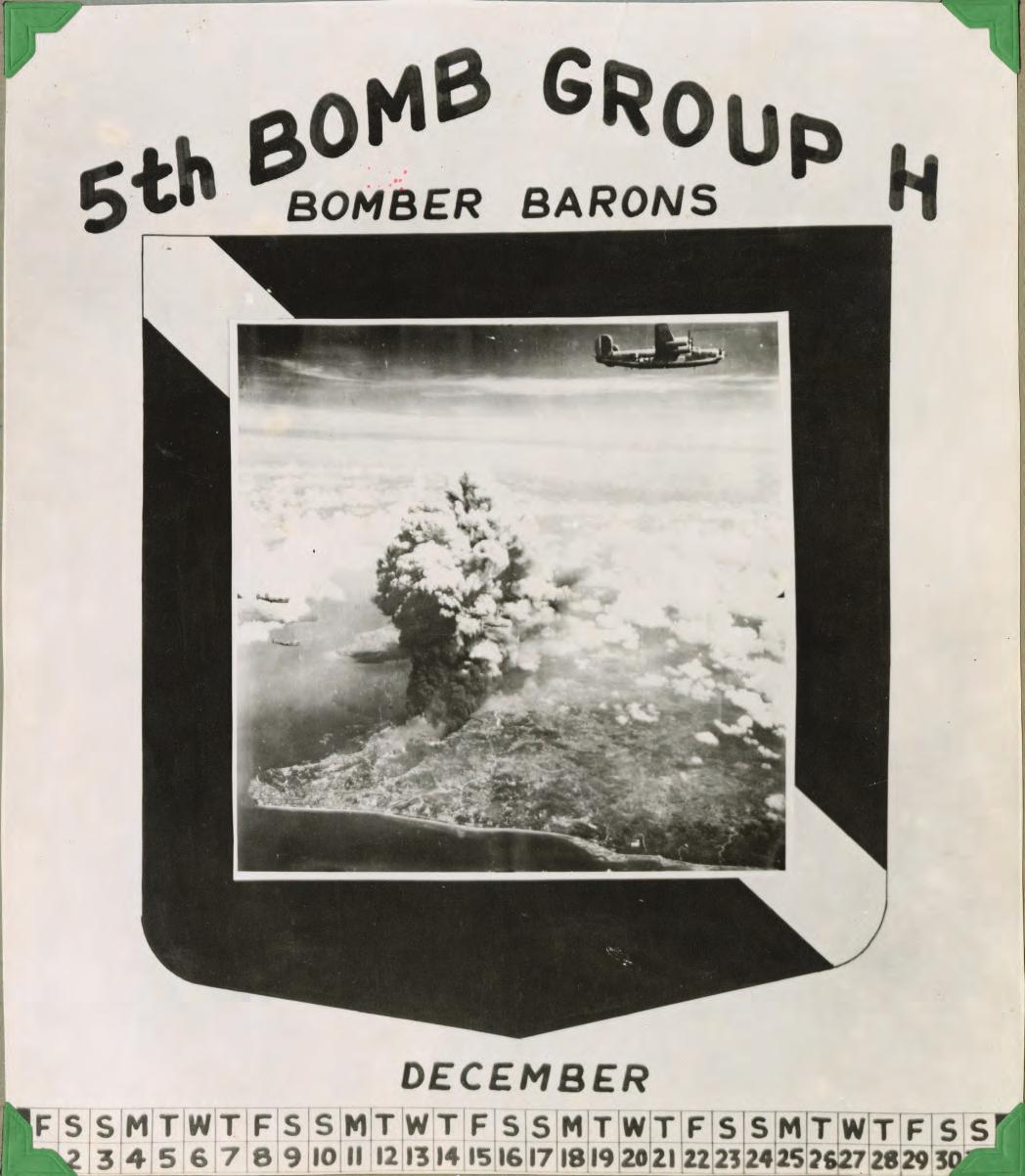
FROM THE DIRECTOR ROM DIRECTO
Dear Friends of the Wisconsin Veterans Museum, Greetings! I hope this finds all of you well and safe. After what seems like an unending winter, it is nice to finally enjoy a Wisconsin summer, with all that means.
The Wisconsin Veterans Museum is based primarily in Madison, but we never forget that our mission covers the entire Badger State. This issue continues our approach of focusing on a specific region of Wisconsin, highlighting stories in our collection from that area. This time we’re going to northern Wisconsin, specifically the counties on the shore of Lake Superior and just south.
You’ll also see content in this issue related to an important service birthday, as this coming September 18 is the 75 th birthday of the independent United States Air Force. Wisconsin has deep ties to the US Air Force, including two of the earliest Chiefs of Staff; some of the stories may surprise you.
Our special exhibit, Souvenirs of Service , remains open and is getting a great response. As I explained to some colleagues who visited recently, it taps into a common theme, as collecting is an ancient and universal human impulse. I asked them to think of their favorite souvenirs and what memories those items recalled. With that in mind, I then sent them to look at the exhibit and consider what veterans brought back and entrusted to us for safekeeping—including some quite unique and powerful memories. If you haven’t seen the exhibit, please stop by.
The museum continues our extensive online offerings which still attract audiences from across the state, nation, and world. These are only possible with the help and support of the Wisconsin Veterans Museum Foundation. I encourage everyone to see what is available at our website.
Enjoy the remainder of summer, and thank you for your continuing support. See you at the museum soon.
Best,
Chris Kolakowski
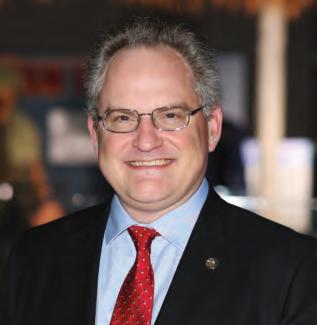
SUMMER 2022 9
EVERY VETER

Harry Newton, a Superior, Wisconsin native, served in Puerto Rico during the Spanish-American War in 1898 and, afterward, enlisted into the federal army for service in the Philippines. While serving as the assistant superintendent of police in Manila, he was hand-picked to be part of a daring and top-secret expedition to capture Filipino president, Emilio Aguinaldo. Posing as prisoners, Newton and a handful of other American troops infiltrated Aguinaldo’s secret camp and succeeded in capturing him in March 1901. While scattered fighting continued, this in effect ended the Philippine-American War.
 By: Russ Horton
Reference Archivist
By: Russ Horton
Reference Archivist

AN IS A STORY

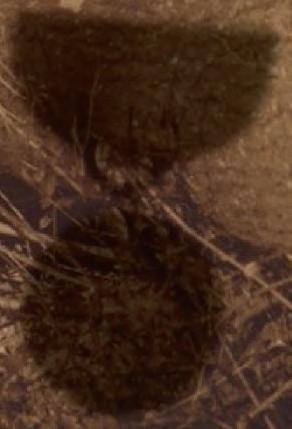




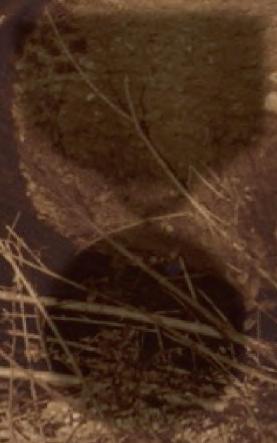


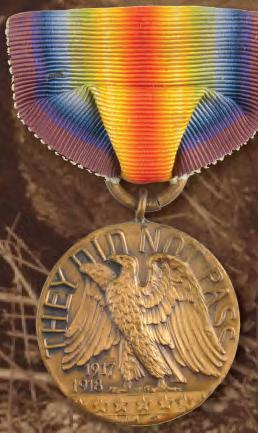


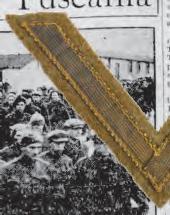


 Cornelius L. Harrington leans against a fallen log somewhere in France, 1918. Wisconsin Historical Society, WHI-107788
Cornelius L. Harrington leans against a fallen log somewhere in France, 1918. Wisconsin Historical Society, WHI-107788
COLLECTIONS FROM THE
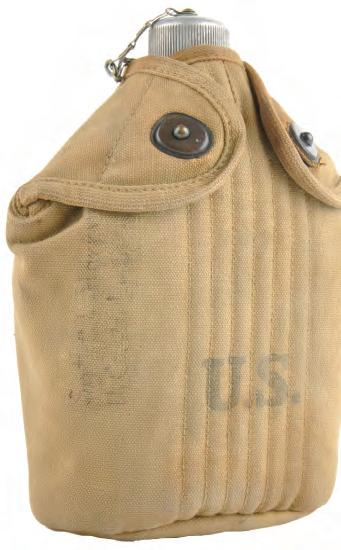

Growing up surrounded by the vast forests and thriving lumber industry of Iron County, Wisconsin directly inspired Hurley native Cornelius L. Harrington to pursue a career in forestry after graduating high school in 1908. Harrington spent his summer breaks employed by the State Board of Forestry before receiving a degree in forestry from the University of Michigan in 1913. He was working in forest management at Trout Lake Nursery in Vilas County when he was drafted into the US Army in September 1917. The 26-year old’s experiences to that point wound up uniquely qualifying him for the specific tasks assigned to the newly created 20th Engineers (Forestry), namely logging timber and operating sawmills to supply Allied troops with critical raw materials for building and construction projects across France.
Harrington completed his specialized training at American University in Washington, D.C. and set sail for Europe in January 1918 as part of Co. D, 6th Battalion, 20th Engineers. Before he even set foot on French soil, however, Harrington met danger head on when his transport ship, SS Tuscania , was torpedoed by a German U-boat off the northern coast of Ireland on the fifth of February. Following directions given to him earlier in the voyage, Harrington found his way to his proper station and boarded his lifeboat. But given the listing of the ship by that point, evacuation procedures became complicated and led to his lifeboat being accidentally released from only one side, spilling all its passengers into the water below. Harrington managed to grab hold of a rope and hang on to the ship until a small rescue boat saved him and 14 others, keeping the group afloat until a larger trawler could safely transport them to the town of Larne on the Irish coast. During his four hours in the rescue boat, Tuscania sank to the bottom of the sea, claiming the lives of over 200 of the 2,400 US Army troops and crew members aboard.

Harrington finally arrived in France at the end of March and spent the remainder of his service situated within the country’s diverse pine forests, engaged in logging and sawmill operations. That October, the 10th Engineers joined the 20 th Engineers, making Harrington part of what had become the largest regiment in the US Army, consisting of an impressive 46,000 soldiers. Before this extensive group had begun preparations to leave Europe the following summer, Harington had already been appointed to a conservation commission created by Wisconsin governor Emanuel Philipp back home. He was discharged as a 1st lieutenant that June and immersed himself in what would become a lifelong passion for expanding the Wisconsin park and forestry system. By 1923, Harrington was named superintendent of Wisconsin’s state forests and parks, a job he held until retiring in 1958. Afterward, he continued to work on writing the history of forestry and conservation in the state until the time of his death in 1966. Later that year, the Wisconsin state legislature honored Harrington’s career-long commitment by naming a park in his honor, Harrington Beach State Park in Ozaukee County.
By: Andrea Hoffman Collections Manager
SUMMER 2022 13
e pi t h p
September 18, 2022 marks the 75 th anniversary of the creation of the independent United States Air Force. It had been a long road from the Army Air Service in World War I, through the Army Air Corps of the interwar period, to the US Army Air Forces of World War II. Fully one-quarter of the eight million members of the US Army in World War II were air forces personnel. By war’s end in 1945, the air forces were ready to move from autonomy to independence—an event helped by postwar organization of the Department of Defense
in 1947. On September 18, 1947, the United States Air Force was born.




When people think of Wisconsinites in the air force, one of the first names that comes up is Milwaukee’s William L. (“Billy”) Mitchell . An early advocate for air power and an independent air force, Mitchell was and remains a guiding light for the modern air force. Milwaukee’s airport is named for him.
The name Dick Bong is also quite prominent, as the Superior native was the highest-scoring American ace in World War II and died
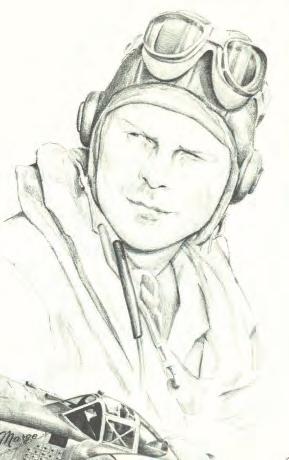

on a test flight in 1945. A state park is named for him, as are facilities in Superior. Both Mitchell and Bong are great parts of Wisconsin’s aviation heritage, along with many from the world wars. But those names can overshadow other Wisconsinites who were involved in the air force after independence. This article will highlight a few of those Badgers.
Several notable US Air Force leaders were born in Wisconsin. Milwaukee’s General Hoyt S. Vandenberg , a noted World War II air commander, became the second Chief of Staff of the US Air Force in 1948
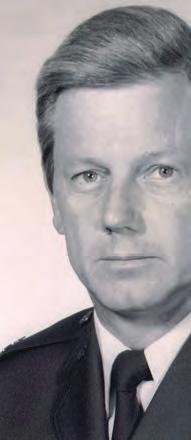
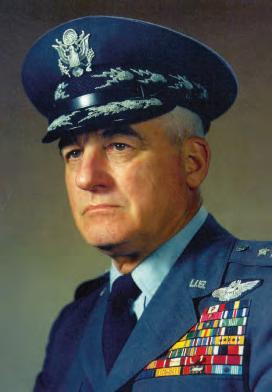
14
succeeding General Carl Spaatz. Vandenberg served two terms as US Air Force Chief of Staff from 1948 until 1953. Vandenberg Air Force base (now Vandenberg Space Force Base) is named in his honor.
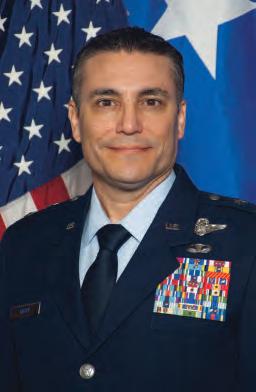
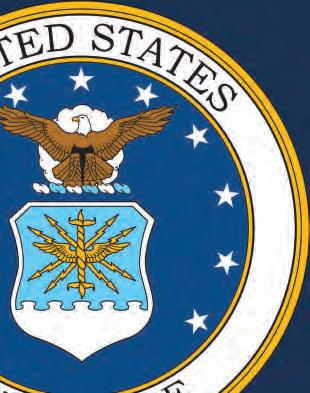
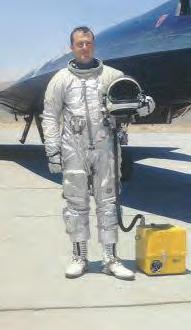
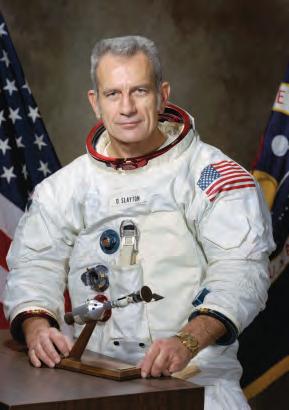
General Nathan F. Twining of Monroe was incredibly influential in the creation of the modern air force as we know it today. During World War II, Twining held several senior posts, ultimately commanding the 20 th Air Force in the Pacific until the end of the conflict. The 20 th Air Force was the command that carried out the bombing of Hiroshima.
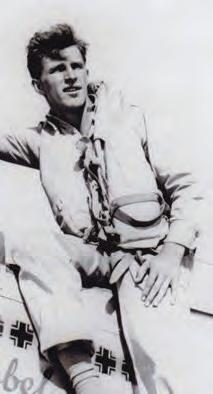
Badgers and the US Air Force

In 1950 Twining became Vice Chief of Staff of the Air Force, serving under Vandenberg— the first and only time the two top commanders of a single military branch were both from Wisconsin. Twining succeeded Vandenberg as Chief of Staff of the Air Force in 1953. In 1957, he was appointed to the Chairman of the Joint Chiefs of Staff.
As chairman, Twining was influential in developing the modern technology and doctrine of the air force. As a deterrence to Soviet expansion, General Twining oversaw the development and launch of the Titan and Atlas missiles in 1959, the first

liquid fueled inter-continental ballistic missiles. He also helped develop the policy of the nuclear triad of landbased missiles combined with submarine-launched Polaris and the strategic air command. He was influential in foreign policy during the Second Taiwan Strait and Berlin Crises. Twining retired in 1960 and is one of the namesakes of Monroe’s Twining Park.
George Cudahy of Kenosha was commissioned as a second lieutenant in the Air Force in 1957. During his time in Vietnam, Cudahy flew 186 combat missions. After his tours, he obtained his

SUMMER 2022 15
doctorate in aerospace science in 1972, and Cudahy served at the Avionics Integration Division before being promoted to colonel and attending the Air War College. He later served as director of the Air Force Light Dynamics Laboratory. After retiring from the air force in 1980, Cudahy worked for Fairchild Republic where he oversaw the engineering and production of the A-10 Thunderbolt II.
Robert Goebel from Racine participated in World War II where he achieved double ace status in 1944 when he destroyed eleven aircraft over 91 days. After World War II, Goebel received his degree in physics from the University of Wisconsin. In 1950, he served with the Atomic Energy and Space Programs in various posts in England, the Pentagon and Albuquerque, New Mexico. He worked with the Gemini Space Program, and after the launch of Gemini VII, Goebel retired from the US Air Force as a lieutenant colonel in 1966.
Deke Slayton, from Sparta, served in World War II. After the war he studied aeronautical engineering at the University of Minnesota. In 1959, he was named as one of the Mercury astronauts after serving as a test pilot at Edwards Air Force Base and was named Chief Astronaut Officer in 1962. Due to a heart condition, it be would ten years later that Slayton made it to space. In 1972, he was assigned to the Apollo-Soyuz Test Project, and he spent nine days in space in 1975.
General Dennis Sullivan of Chippewa Falls was an aviator with over 7,000 hours flying experience and a member of the Society of Experimental Test Pilots. He served as a special projects officer at the Pentagon and with the CIA Oxcart Mission to find the successor to the U-2, which ultimately led to the creation of the SR-71. While stationed at Beale Air Force Base from 1970-1972, Sullivan served as Vice Commander of the 9 th Strategic
Reconnaissance Wing, the home of the SR-71. In 1983, Sullivan became the Command Director in the Cheyenne Mountain Complex for the North American Aerospace Defense Command (NORAD).
Wisconsin’s US Air Force heritage encompasses more than these senior officers. The museum’s artifact, archival, and oral history collections include many air force veterans—everyone from aircrew to missile technicians, to medical and administrative personnel, to mechanics, and everything in between. Many of these stories are displayed in the museum’s galleries and traveling exhibits, such as Kimberly Stuart , who is featured in the I Am Not Invisible traveling exhibit. Stuart said, "I became the first female Electromechanical Team Chief. It was a very big deal. I didn't realize it was. I was excellent at what I did."
Repeatedly in these stories, pride in service stands out. “Going through basic training, I think, shaped me dramatically into what the military actually was, to what it stood for, how much we could kind of offer to our country,” said Madison’s Julie Murray, who deployed to Iraq with the Wisconsin Air National Guard.

“I’m very proud of my service,” said Beloit’s Ann Brink , a nurse who served at Vandenberg during the Vietnam era. “I think it’s a really great experience for anybody.”
These are the highlights this space allows on this broad topic. Anyone interested in exploring these, or other, US Air Force stories from Wisconsin will find many more on the museum online catalog on our website.
By: Chris Kolakowski & Gregory Lawson
16
Nearly 160 years ago, the Emancipation Proclamation ended slavery in the Civil War South. Did you ever wonder how that event affected Wisconsin? Join the Wisconsin Veterans Museum for their annual Talking Spirits XXIV: Forest Hill Cemetery Tours to see, hear, and experience how this document changed the lives of future Madisonians and Wisconsinites. These tours will take place during the week of October 3-9, 2022 at Forest Hill Cemetery. Candlelit tours will be held on October 8th and public (daytime) tours will be held on October 9th.

Howard Brooks Born in the institution of slavery in Virginia, Brooks gained his freedom when the Union Army came through his area of the south and he immediately joined them. He served in the 29th US Colored Infantry until the end of the war in 1865. He was one of the first Black men to receive a government pension for his service.
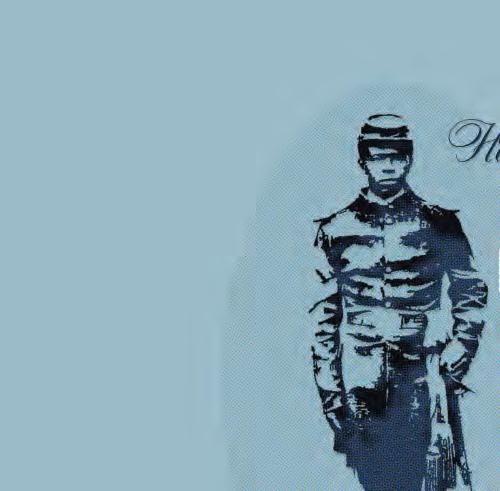
John Jefferson—Born John Hemings in 1835, he was the grandson of President Thomas Jefferson and one of his enslaved servants, Sarah ‘Sally’ Hemings. John Jefferson grew up in a free Black community in Ohio and took the surname ‘Jefferson’ upon moving to Madison in order to identify as White. As a White citizen, he was able to serve as a colonel in the 8th Wisconsin Volunteer Infantry during the Civil War and went to great lengths to hide his ancestry.
Nodley Henderson—Nodley, who had previously been enslaved and gained his freedom, served in the Civil War and was one of the first Black landowners in Madison. He often took in newcomers on his farm, especially formerly enslaved people and Black soldiers who fought in the war.

William and Anna Mae Miller —The story continues with the next generation as we look at the lives of Mr. and Mrs. William Miller. The Millers were active in the improvement of conditions for Black people in Madison. William helped organize the St. Paul’s African Methodist Episcopal Church and was an aide to Senator LaFollette for 19 years. Anna Mae was the founding member and long-time treasurer of the Madison chapter of the NAACP. Their home, built in 1853, was moved to E. Dayton Street in 1908 and is still a Madison landmark.

17
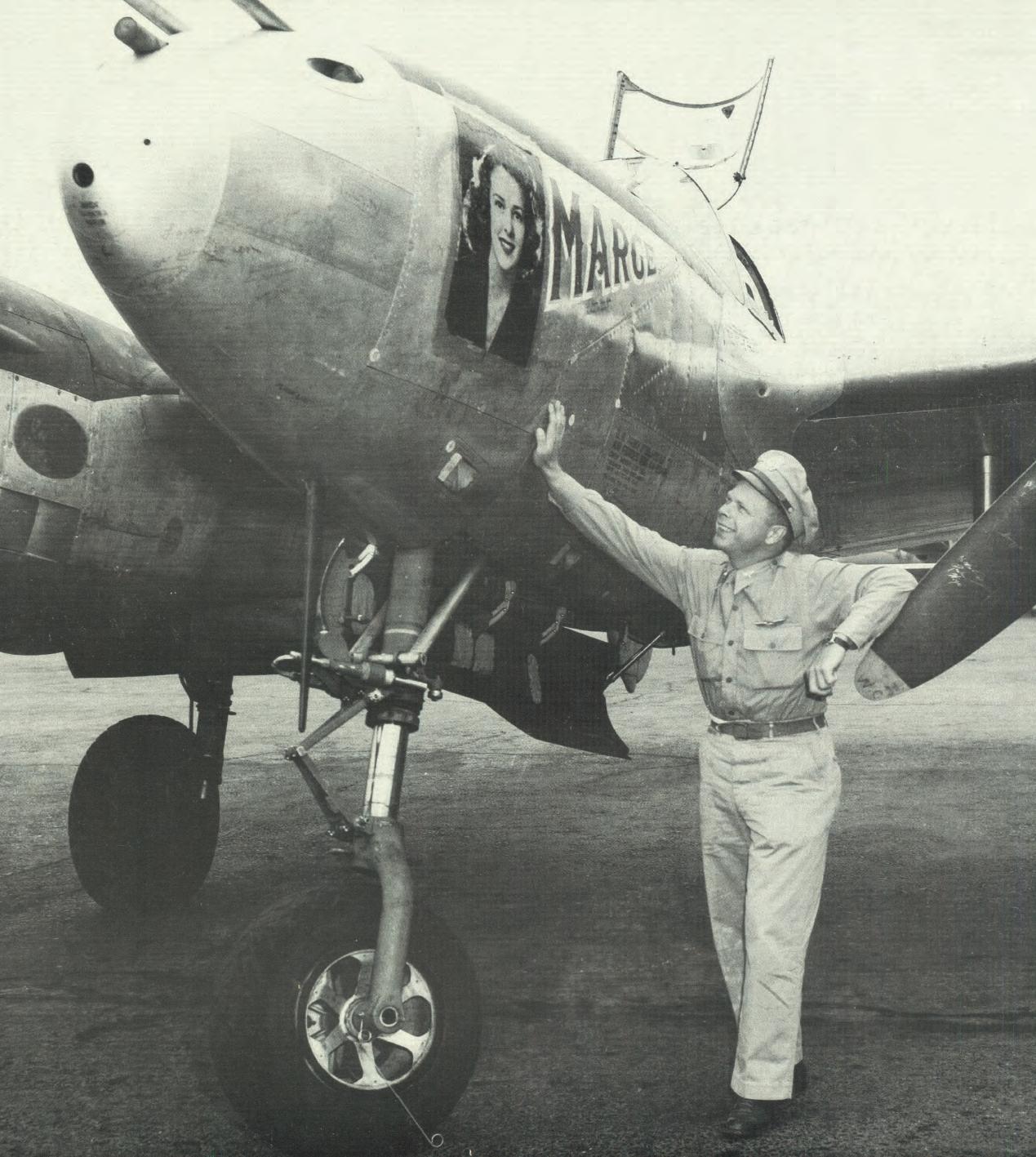



18
ARCHIVES FROM THE
Richard Ira Bong, born in Superior and raised in Poplar, Wisconsin, served with the 49th Fighter Group, 5th Fighter Command, 5th Air Force, Army Air Corps in World War II. During his service, he became one of the most decorated American fighter pilots, dubbed the “Ace of Aces” for his 40 aerial victories in World War II. On December 12, 1944, Bong was presented with the Congressional Medal of Honor by General Douglas MacArthur for his conspicuous gallantry and intrepidity in action above and beyond the call of duty. After he secured his 40th aerial victory, Major Bong was ordered to return to the United States, eventually returning to his hometown in Wisconsin.
On February 10, 1945, Major Bong married his sweetheart, Marjorie Vattendahl, in Superior. Following their honeymoon, the couple was stationed in California in order that Major Bong could test a new plane, the Lockheed P-80 Shooting Star. While on a test flight on August 6, 1945, Major Bong’s plane stalled and crashed, killing the 24-year-old major. Family, including Marjorie, learned of his passing on the radio.

Prior to his passing, Marjorie had decided to write a biography about her husband. Following his death, she wrote a series of articles, which chronicle their courtship, wedding, and life as a married couple. At the end of the final article, she declines to recount the events of that day. Instead, she wrote:
“It is as difficult to write about it as it is to talk about it. I am trying, but I cannot force myself to write the tragic details of the rest of that Monday. All save one thing that Richard did – Something that makes me even more proud to be Mrs. Richard Bong. ‘When he discovered that something was wrong with his plane, he was over a residential area. According to the witnesses and residents of North Hollywood, he guided his ailing jet plane over those homes, skirted high tension wires, to a vacant lot, so nobody but himself would be in danger.’ Possibly he could have saved his own life. But doing so, he would have had to abandon his plane, causing damage and destruction to the families below. He did not do that. Not until he was sure that nobody else would be hurt, did he think of himself. That was true heroism, in every sense of the word.”
Living most of the rest of her life in California, working as a model, writer and publisher, Marjorie Bong Drucker returned to Wisconsin before she passed in 2003. She is buried in the Bong family plot, Poplar Cemetery, Poplar, Wisconsin next to Major Richard I. Bong.
Articles written by Marjorie Bong Drucker can be found at the Wisconsin Veterans Museum, WVM Mss 655. These articles also were published in newspapers, including the Minneapolis Star Tribune.
By: Brittany Strobel Processing Archivist
SUMMER 2022 19
The Bell UH-1 Huey is a multi-role American helicopter that entered service in 1957. It is widely known from the Vietnam War where it functioned as a transport, air support and medical helicopter. Many types of weapons were mounted on the helicopter including a machine gun on the transport sides, and in the support version 70 mm unguided missile pods and the M134 Minigun rifles. Twelve soldiers could board the helicopter.
Hanging in the galleries of the Wisconsin Veterans Museum is a Huey from the 174th AHC. The 174th Aviation Company AHC activated at
BELL "UH-1 HUEY IROQUOIS" $87.95



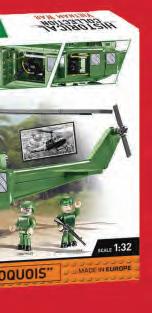
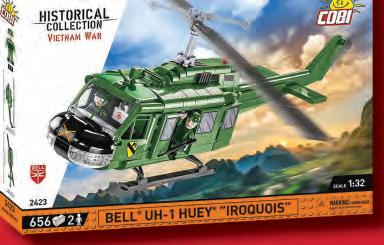
• 656 high-quality blocks




• 2 crew included in this model featuring several moving parts for play
• A plate with the printed name and the BELL logo for item display

• Clear and intuitive instructions based on illustrations and step-by-step directions
• Fully compatible with other brands of construction blocks

• Skill level: intermediate
Store.WisVetsMuseum.com



Fort Benning, GA October 1965 under the authority of General Order Number 278. Personnel began arriving at Fort Benning on 1 November 1965 under the command of Maj. Robert M. Stuart.
The 174th was organized to airlift combat troops, supplies and equipment into a combat zone, and to perform command and control missions, as required, in conjunction with both ground and airmobile assaults. They served in Vietnam from 1966 to 1971. During that time, the company was known as the "Sharks" for the nose art on their Hueys. They’d petitioned the Flying Tigers of WWII to have the iconic shark teeth on their machines.
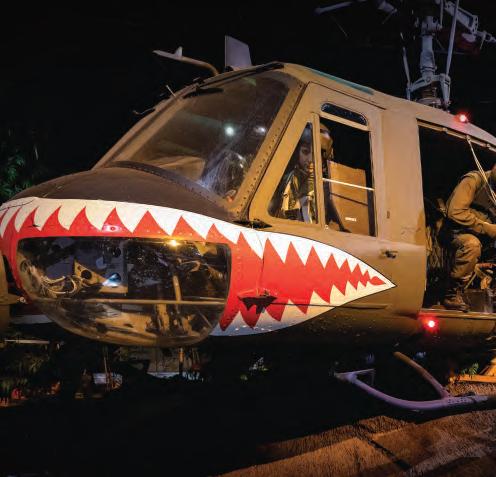
20
If you’ve taken a tour, played museum trivia, attended a program, or walked a cemetery tour, you’ve encountered the work of Erik Wright. Since November of 2018, he has served as the education specialist at the Wisconsin Veterans Museum. Erik artfully redirected inperson museum events during the pandemic to a successful slate of virtual programs that continues out of demand and not necessity.
Erik grew up in southern California. As a young adult he realized the west-coast punk scene was taking him nowhere. He said, “I knew I’d either be dead or in jail if I didn’t do something, so I did something.”
That something was enlisting in the US Army. Erik served from June of 1990 to October of 1998. He saw action in Desert Storm and Desert Shield in an M1A1 tank. Erik is extremely proud of his son, Captain Wright, who has carried on the tradition of army service in the armored division.

The army enlistment provided Erik experiences and skills that he would learn nowhere else, and his life took a new direction. After his discharge at the rank of sergeant, he used the G.I. Bill to attend college to study history and social science with the intent of being a college professor.
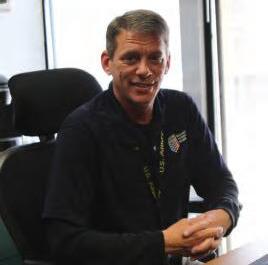
The need for money often gets in the way of our dreams as it did for Erik. He ran out of money studying in Europe and returned

home. “While I was looking for a job, I started volunteering at the National Atomic Testing Museum in Las Vegas, Nevada. That museum offered him a job shortly thereafter. He’s worked in museums ever since. Before beginning with the Wisconsin Veterans Museum in November of 2018, he worked with the US Navy museum systems at Great Lakes, Illinois.
Obviously, he enjoys his work. “I like to educate people about military history. That’s an eyeopening experience on most days. Most people don’t know their history. When you start to explain events that have consequences and reverberations today. It’s fun to see people’s light bulbs go off when they understand why that matters. ‘Oh yeah, I never thought of that.’ I love seeing that expression on people’s faces.”
Erik’s experience in the service continues with how he views the role of education at the museum. He wants you to know that, “The education department is far more accessible than people would think. We are open to many ideas for both with programming and touring, and so if there is any unique thing that you would like to do at the museum, contact us and chances are we can probably do it for you.” Give him a challenge.
By: Jennifer Stevenson Marketing Specialist, Sr.



SUMMER 2022 21
MEET THE
MUSEUM STAFF
d kn start I
Army Tanker Turned Museum Educator: This Is Erik Wright
BEHIND THE SCENES
VISITOR SERVICES: MEETING PEOPLE WHERE THEY ARE AT



22
The people at the front desk are likely the first and last impression of the museum you experience when you visit. The Wisconsin Veterans Museum Visitor Services team includes gift shop manager, Gregory Lawson and several associates, including Michael Olson, Molly Snow, Sydney Curtis, and Ellen Greenwold . Between that hello and thanks for visiting, the visitor services team humbly works to meet people where they’re at.
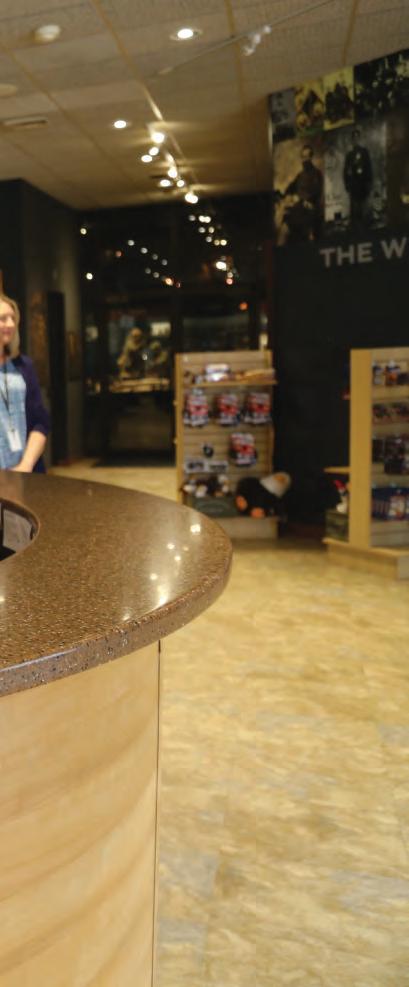
Anticipating the needs of our visitors begins with knowing what’s happening. The visitor services team functions as the eyes and ears of the organization as well as managing roles as the public face of the museum. The team operates as a sort of museum concierge which requires them to stay current with museum programs, exhibits, current events, upcoming tours, new gift shop merchandise, donation processes and procedures, and what’s happening on the Square, because they’ll be asked about all of the above during the course of a week. And how do they do that? They read: exhibit labels, press releases, museum publications like The Bugle , and dust jackets of the books we sell. In addition, they volunteer to help the staff with research projects and developing tours.

Concerning museum operations, this group is responsible for managing the museum’s gift shop. They put all their passion for history and our veterans into researching and gathering products to enhance the visitor’s museum experience. The staff is proud that the shop offers as wide a selection of products. The merchandise is often made in the U.S.A., sourced from a veteran-owned company, and/ or one that benefits veterans’ causes. In addition, the staff is mindful to select items that enhance the patron’s experience by supporting the museum mission and its core beliefs that Every Veteran Is a Story, Wisconsin Was There, and It Still Matters .
The visitor services team links the work of the staff with the needs of our audience. They share their observations of visitors with the staff to ensure the museum exceeds the expectations of every person who walks through our doors. From the physical environment in the gallery spaces to the most asked questions from guests, the visitors service staff is the receiver and disseminator of that information. The visitor services team is the frontline for meeting our visitors where they’re at physically in the museum and ensures the work that happens by other staff behind the scenes does as well.
SUMMER 2022 23
FEATURING DON WEBER
SPONSOR THE SERIES | NOVEMBER 12, 2022 | LA CROSSE, WI
EXCLUSIVE $5,000
• Named as “Presenting Sponsor” in all Convoy promotional materials and media interviews
• Sponsor’s name added to the Museum’s Wall of Honor in the lobby of the Museum
• Six seats reserved for the program and VIP reception with Don Weber
• Private tour with the Director of the Wisconsin Veterans Museum at the new collection’s facility
THREE-STAR $2,500
• Listed in all Convoy Series promotional materials
• Sponsor’s name added to the Museum’s Wall of Honor in the lobby of the Museum
• Three seats reserved for the Convoy program and VIP reception
TWO-STAR $1,000
• Two seats reserved for the program and VIP reception
• Listed in all Convoy Series promotional materials
ONE-STAR $500
• Sponsor’s name will be included on signage at the event and listed on the event website
HERO SPONSOR $250
• Underwrite the cost for a current member of the military and their guest to attend the event
• Hero will receive a Family Membership for the Wisconsin Veterans Museum
24 FOUNDATION
CHECKPOINT: WEBER ARTS CENTER, | LA CROSSE | SEE ENVELOPE FOR DETAILS

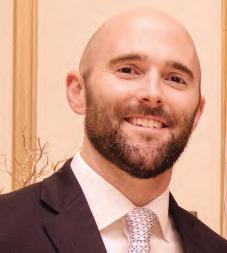
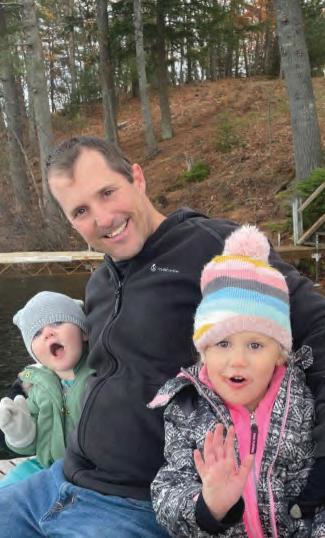

SUMMER 2022 25
8
Mark Your Calendar
VIRTUAL DRINK & DRAW
7:00–8:00PM
Gather your art supplies, pour yourself a beverage, and bring your artistic energy as we spend the evening together stretching our creative muscles.
18
VIRTUAL BOOK TALK
12:00–1:00PM
William Woolley will be joining us to talk about his newest work, Creating the Modern Army: Citizen-Soldiers and the American Way of War, 1919–1939, which looks at the creation and growth of the US Army during the interwar years.
19
VIRTUAL TRIVIA NIGHT
7:00–8:00PM
Join us for our virtual trivia night and test your historical knowledge. Individuals and teams welcome.
29
VIRTUAL MOVIE NIGHT
7:00–8:00PM
Pork Chop Hill (1959)
Grab some popcorn and a seat in your favorite chair and join us for a virtual discussion of the selected movie with the Wisconsin Veterans Museum staff.
VIRTUAL BOOK TALK
12:00–1:00PM
John McManus will be joining us to talk about his newest work, Island Infernos: The US Army's Pacific War Odyssey, 1944, which explores the Army’s dogged pursuit of Japanese forces, island by island, throughout 1944, a year that would bring America ever closer to victory or defeat.
VIRTUAL DRINK & DRAW
7:00–8:00PM
VIRTUAL TRIVIA NIGHT
7:00–8:00PM
18
MESS NIGHT (IN PERSON)
5:30–8:00PM
Zero-Sum Victory: What We’re Getting Wrong About War
Please join us for Mess night with guest speaker Chris Kolenda. Relying on historic examples and personal experience, Kolenda draws thought-provoking and actionable conclusions about the utility of American military power in the contemporary world—insights that serve as a starting point for future scholarship and important national security reforms.
VIRTUAL BOOK TALK
12:00–1:00PM
Craig Whitlock will be joining us to talk about his newest work, The Afghanistan Papers: A Secret History of the War, which looks at how three successive presidents and their military commanders deceived the public year after year about America’s longest war, foreshadowing the Taliban’s recapture of Afghanistan.
VIRTUAL MOVIE NIGHT
7:00–8:00PM
Is Paris Burning? (1966)
Grab some popcorn and a seat in your favorite chair and join us for a virtual discussion of the selected movie with the Wisconsin Veterans Museum staff.
VIRTUAL BOOK TALK
19
12:00–1:00PM
Michael Hankins will be joining us to talk about his newest work, Flying Camelot: The F-15, the F-16, and the Weaponization of Fighter Pilot Nostalgia, which explores the post-Vietnam era, when the US Air Force launched two new, state-of-the art fighter aircraft: the F-15 Eagle and the F-16 Fighting Falcon.
*For detailed information and registration visit: WisVetsMuseum.com/events
JUL
AUG
22
SEP AUG
$38 Members | $46 Non-Members | $30 Students (W/ID)
8 12 16
26
THANK YOU DONORS A most sincere thank you to all who donated from March 2022 through end of May 2022. We cannot provide quality programming and award-winning exhibits without your help.
2nd Wisconsin Volunteer Infantry Association, Inc.
Cullen, Mark
Bonack, Donald
Harned, Lewis
Heiliger, Jr., Donald
Hooper Foundation
J.P. Cullen
Naleid, William
Reiland, Tim & Liz Orella
Van Kauwenbergh, Gary & Darlene
Wilkening, Patricia
Wagner, Dennis
Adams, Cheryl
American Legion Post
0141 (Stuessy-Kuenzi
Post)
Barnett, Jim
Bieniek, Brian
Bublitz, James
Carlson, Jen
Colbert, Laura Elizabeth
CTW Abbey Carpet & Floor
Culver’s at Cottage Grove Rd. & Todd Dr.
DiSalvo, Tony
Fargen, Joseph
Fonger, MAJ Linda & COL Michael
Hagen, Scott & Natalie
Hall, John
Hall, Tyson & Danielle
Heiliger, David
Heinritz, Melinda & Mark
Howell, Jonathan
Hundt, Michael & Lori
Hustad, William & Jackie
Icke, John & Karen
Johns, Jason
Johnson, Richard & Brenda Kelly, James & Carol
Ketterer, George
King, Jeannette
Kromanaker, Lisa & Alan
Krueger, Cal & Susie
Kurtz, Anthony & Kimberly
Madison Navy League
Markert, Bruce & Kathryn
McGeshick, Roger
Millsap, Nathaniel
Moninski, Kenneth
Myers, Robert Norfolk Historical Society
Olesen, Gerald
Olson, James
Orlowski, Robert
Patterson, Bill
Rabinowitz, Abe
Rathmann, Richard
Schmelling, Audrey Schrag, Beverly Schrum, William
Sloan, Fred & Nancy
Smith, Gary Still, Kathy
Sub- Zero Wolf
Foundation, Inc


SVA Certified Public Accountants
Turek, Dan
VFW Post 9511 (Mount
Horeb Centennial)
Viner, Orrin Wisconsin Broadcasters Association
Wisconsin Vietnam Vets Chapter 3
American Legion Post 0257 (Beckett-Kurth Post)

American Legion Post 0493 (Linden Post)
Arango-Escalante, Alejandro & Erin
Bach, Daniel
Bachmann, Richard

Best, Linda
Borchert, Gerald
Bovre, Michael
Budish, Marilyn
Christensen, Ronald & Linda
Collins, Chaplain, Rev. Dean
Coronna, Mark
Duck, Holly
Dugan, Sean
Grimm, Philip
Gruennert, Jim & Joann
Haag, Douglas
Haidinger, Shirley
Hanson, Bob
Hanson, Sharla
Holmen, Dale & Debra
Isensee, Natalie
Janz, James
Jevens, Lowell
Kadlec, Robert
Kallas, Phillip & Priscilla
Kelly, Joanne
Kind, Arn & Margaret
King, Kathleen
Klem, Bruce
Koeppen, John
Krikelas, Andrew
Lewke, Carl
Lipka, Michael
Mann, Robert
Mathers, Kyle
Mc Ternan (Ret), LT COL
George
McFarland & Company
Inc. Publishers
Millane, James & Monica
Miller, Rick
Mullins, Michael & Karen
Murrie, James
Phelan, Joan
Phillips, Gene
Porth, Guy
Powles, John & Joanne
Race, John & Rita
Radosavljevic, Julie
Rasmussen, Steve
Robbins, William & Chris
Roden, Robert
Rosen, Maxwell
Rusch, Lynn
Sayles, William
Schroeder, John
Schroeder, Paul
Shullsburg High School
Smith, Ken & Linda
Sommers, Mike & Mary
Speracino, Denise
St. Charles Catholic
School
Wagner, Gregory
Weber, Nicholas
Wegner, David & Mary
Wolf, Richard & Marjorie
Woolley, William & Jean
Wren, Christopher
Zehren, Geraldine
Ziegenhorn, Mark
Zimbric, Gerald & Hazel
27
CALL 608.261.0536 or JOIN ONLINE at WWW.WISVETSMUSEUM.COM Click on Join | Give GIVE the GIFT of MEMBERSHIP Today! THE WISCONSIN VETERANS MUSEUM 30 WEST MIFFLIN STREET MADISON, WI 53703
















 Photograph from the Merton W. Baker collection, WVM Mss 2261. This photograph features Baker, center, with other US Air Force servicemembers, in front of an air force plane.
Photograph from the Merton W. Baker collection, WVM Mss 2261. This photograph features Baker, center, with other US Air Force servicemembers, in front of an air force plane.

















 By: Russ Horton
Reference Archivist
By: Russ Horton
Reference Archivist















 Cornelius L. Harrington leans against a fallen log somewhere in France, 1918. Wisconsin Historical Society, WHI-107788
Cornelius L. Harrington leans against a fallen log somewhere in France, 1918. Wisconsin Historical Society, WHI-107788

























































